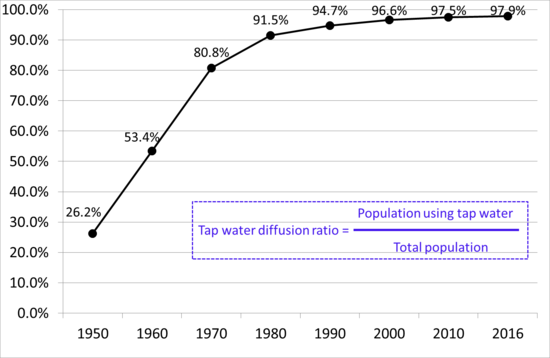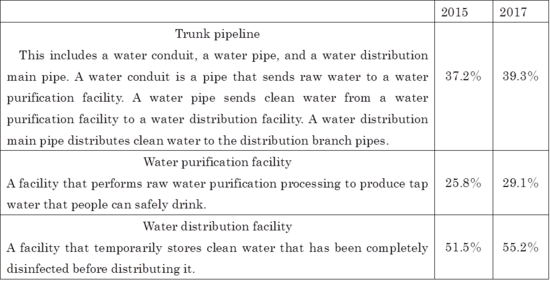Column Finance and the Social Security System 2019.04.18
【Aging, safety net and fiscal crisis in Japan】No.178: Securing tap water is becoming difficult under population decline
In this column series, Yukihiro Matsuyama, Research Director at CIGS introduces the latest information about aging, safety net and fiscal crisis in Japan with data of international comparison.
Aging
Society&Others
According to a report released by the World Health Organization on April 3, 2019, 26% of medical facilities in the world lack the basic capability to ensure safe water. Conversely, in Japan, high-quality water can be secured for use by both medical facilities and homes. This is the result of continued investment in the tap water supply (Figure 1).
However, various problems endanger the likelihood that the current benefits of tap water will be available in the future.
- (1) Increasing the earthquake resistance ration of tap water supply facilities is delayed. As shown in Table 1, as of 2017, the earthquake resistance ratio for trunk pipelines, water purification facilities, and distribution reservoirs is 39.3%, 29.1%, and 55.2%, respectively. As a result, when a large earthquake occurs and water pipes break, the likelihood of a long recovery time increases.
- (2) The legal service life of water pipes is 40 years. Due to a lack of financial resources, the ratio of water pipes that have been in use for over 40 years has increased from 6.0% in 2006 to 14.8% in 2016 (Figure 2).
- (3) The government estimates that the nationwide water demand per day will decrease from 36 million ㎥ in 2015 to 22 million ㎥ in 2065, due to the spread of water conservation equipment and the population decline. Meanwhile, the government estimates that it is necessary to continue investing 1.9 trillion yen every year for the next 20 years, even if the demand for water is decreasing. This amount exceeds 1.7 trillion yen, which is the average annual investment amount that was allocated to water facilities from 2007 to 2016. The increase in financial resources is needed to finance delayed earthquake resistance measures and the renewal of old facilities.
- (4) Tap water supply organizations heavily depend on utility charges paid by users. To continue making significant investments while the water demand decreases, it is necessary to significantly raise the rates for water utilities.
- (5) The number of tap water providers is 5,629 as of 2015. Most are organizations established by municipalities and are small in scale. About a third are in deficit. To improve their financial balance, it is urgent that they expand their existing scale through mergers, but the speed at which these take place is slow.
 Source: Ministry of Health, Labour, and Welfare
Table 1. Earthquake resistance ratio of water supply facilities
Source: Ministry of Health, Labour, and Welfare
Table 1. Earthquake resistance ratio of water supply facilities
 Source: Ministry of Health, Labour, and Welfare
Figure 2. Water pipe aging ratio
Source: Ministry of Health, Labour, and Welfare
Figure 2. Water pipe aging ratio
 Source: Ministry of Health, Labour, and Welfare
Source: Ministry of Health, Labour, and Welfare
